I had someone approach me recently for some notes on game design. He is developing a set of rules for WWI and is looking at taking his ideas to the next level of polish and sophistication. He sent me an Email after a recent convention in which some of his ideas did not play as well on the table as he had hoped. Several of the folks who were copied on the conversation commented that they found my post interesting, so I thought I would share it with a larger audience. I have paraphrased my answers to him in this article.
In game design general I prefer d10 (ten-sided dice) and d20 (twenty-sided dice) over d6 (six-sided dice). (As an exception, when working on the Look, Sarge, No Charts family of rules I went with d6 for custom dice, because blank cubes are easy to find, while blank d10 or d20 are expensive, rare, and have smaller faces for results and information.) My preference for d10 and d20 is especially pronounced if someone is rolling multiple d6. When you begin rolling multiple dice, regardless of the number of faces, the results begin to form a probability distribution that looks like a normal, “bell” curve. Rolling a single d10 or d20 gives you a uniform probability distribution (that looks like a straight, horizontal line).
Why does that matter? I think that a modifier (say +1) should have the same effect, regardless of the number you’re modifying. A +1 on a d10 has the same impact, whether you were trying to beat an 8 or a 4. You have added (or subtracted) 10%. When rolling 2d6 (two six-sided dice), a +1 modifier has a greatly different impact whether the player is trying to beat a four or a seven. Also, the more dice you roll, the more average the results will be. With a single d10 or d20, you always have that uniform distribution. I think in a war game, you want to allow for a wide spread in results, rather than bunching up in the center, because combat is inherently unpredictable.
In simulation design, we talk about two orthogonal dimensions: fidelity and resolution. Resolution relates to the amount of detail. A high-resolution combat model might represent the individual subsystems, such as sensors, weapons, engines, etc., where a low-resolution model might represent a tank as a single thing with some attributes. Depending on your use case, neither model is inherently superior; however, you need to use the right tool for the job. When supporting training, the low-resolution model will often provide the same (or better) results than the high-resolution model, but if a researcher wanted to determine the potential impact of a new sensor system on the performance of a unit in combat, he might need the high-resolution model.
Fidelity, on the other hand, is a measure of the accuracy of the simulation results — for a particular use case. I think many game designers have bags of modifiers that provide an ILLUSION of fidelity. One can model a coin toss with a d6 where 1-3 is heads and 4-6 is tails. That is a simple model and will achieve results that are nearly indistinguishable from tossing a real coin. On the other hand, one could have a detailed, physics-based model of a coin that takes into account the bumps on the surface of the coin, its weight, height above the ground, air temperature and density, the properties of the surface on which it’s going to land, etc. The latter model has high resolution (i.e. lots of detail), but perhaps no better fidelity than the former.
So… accuracy and detail, or fidelity and resolution, are not necessarily correlated. Gamers often talk about “simulation” vs. “game.” In the end all war games are a balance between fidelity and resolution. We’ve all played high-resolution war games (e.g., Empire) and lower-resolution war games (e.g., Shako). Which has better fidelity? The answer is, “it depends.” Empire represents aspects of the skirmish fight and grand tactical maneuver that most games ignore. Does that matter? It does if you think those are the key aspects of warfare in that period that must be reflected in order to achieve the desired fidelity. If at the end of the day, the two simulations achieve the same (approximate) battle outcome, perhaps there is no difference in fidelity. I would argue that a careful designer, who really spends some time looking at his probability distributions and works hard to identify the important aspects of the period, can build a low-resolution simulation with the same (or higher) fidelity as a high-resolution one. In fact, I’ve played high-resolution games that have worse fidelity than low-resolution games!
Why did I subject everyone (who stuck with me this far) to this diatribe? As you design a game, I think you need to think really hard about modifiers. Play testers are going to try to get you to apply more and more modifiers during your play tests to account for every not-quite-right situation that occurs in your play tests. Beware!!!
“I think that the Imperial Werewolf Brigade, with their air-powered repeating rifles, should get a +1 in fire combat, because at the 13th battle of Fredonia, they held a bridge 30 minutes longer than the Morrocon Zumba Band.” “Units with triangular bayonets should get a +1 in melee vs. units with knife-style bayonets.” In the last 20 years, I’ve heard a lot of them. The point is that if God had rolled like some of the folks in our gaming club instead of like a kid, the Imperial Werewolf Brigade might have fought poorly at Fredonia. Give your dice a wide, uniform distribution, and let probabilities handle those variations.
Whether a unit is having a good day or bad day, whether the quartermaster failed to draw enough ammunition, whether the commander is particularly inspirational during the battle are all accounted for by the throw of the dice. The rules and modifiers, need only concentrate on those BIG things. By using a d10, the game designer forces himself to constantly ask the question, “Is that event at that battle or that aspect of warfare during the War of Jenkins Ear really worth a 10% bump?” (You can ask the same question about a 5% modifier with a d20.) If the answer is “no,” don’t include it.
Let’s use morale as an example. I would argue that morale is about as random a phenomenon as you can get. Brother Against Brother has represented morale just about right to me in this regard. What makes a unit run away at the first shot in one battle and the same unit fight like tigers to the last man at the next battle? I’ve seen many rules sets with dozens of modifiers to a morale test. I’ve even seen some that try to rate many regiment’s morale at each battle of the Napoleonic wars in which they fought! In the end, I would argue that there are really only three things that really matter enough about morale to be represented in a game’s morale test: whether the unit has taken losses (and perhaps how many losses), whether the unit is in cover of some sort, and whether the unit has a proven track record of better morale. All those other modifiers add little fidelity at the cost of greater resolution. In one game I designed I had a different modifier for whether a unit was threatened with being cut off (a negative modifier to the morale roll) and whether it actually WAS cut off (a positive modifier). Include those modifiers needed to represent the historical period, but only apply those MOST important modifiers.
As I’ve continued to design games, I went from trying to get everything onto six 8.5″x11″ chart cards (Battles for Empire, when Empire had a dozen cards and two fold-out flow charts) to two chart cards (Beer and Pretzels Skirmish), to one chart card (Santa Anna Rules! and Wellington Rules!), to a 3.5”x5” chart card (G.A.S.L.I.G.H.T.), to no chart cards. That doesn’t just happen without a lot of thought, analysis, introspection, and trial and error. I’m toying with a revision to Beer and Pretzels Skirmish that will fit on a 3×5 card. This amount of refinement is HARD and often unappreciated.
Don’t get the idea that you can just jettison detail, however. I’m not implying that all detail is bad, just that you need to be judicious in selecting exactly the RIGHT detail to represent those aspects of a particular historical period that YOU think define the period. Otherwise, a set of rules will not feel much like any particular historical period. If you remove too much resolution you impact fidelity; you end up with a fist-full-of-dice with a lot of modifiers, but in the end, it’s just about “6’s are hits.” It takes more thought than most realize to really distill a period down to the MOST salient features and develop a de minimus set of mechanics / systems that represent those.
Do not let your enthusiasm for a particular period of history drive you into “modifiers Hell.” We’ve all been in those conversations – often started by a disgruntled gamer trying to trip up a game master during a convention game – that start as a bunch of peacocks trying to impress each other with their detailed knowledge of the most arcane details of some historical period. I watched two grown men stop a war game to argue for 30 minutes about the size of the white starts on the sides of US tanks in WWII! The rest of us who just wanted to get back to the game were truly edified. Not. Your job as a game designer is not to impress the reader in your knowledge of minute details. Your job is to impress the players at the end of the game with the fidelity of the game result.
This approach has its detractors. I’ve been criticized in the past for games with good period feel and historically-defensible results because it lacked modifiers and systems to reflect this or that aspect of a period. Period feel is important, but too much of it can provide that high-resolution illusion of fidelity.
Finally, game design is like art. There can only be one sculptor, and in the end he must be happy with the statue. One year I visited the decoy museum in Havre de Grace, Maryland. They’ll tell you that making a decoy is easy. Take a block of wood and carve away everything that is not a duck, and you’ll be left with a beautiful decoy. Creating a set of rules involves the seamless — and hopefully consistent — set of systems that must interact in a synergistic way. You can take a bag of mechanics you like from other games and cram them together, but they won’t feel like a single, uniform, consistent playing experience. It is the seamless, consistent interaction of the various sub-systems that makes a set of rules elegant. I like to judge a set of rules on the number of special cases and exceptions. The more of these there are the less well integrated the various subsystems are.
I’ve mentioned consistency a couple of times. Let me clarify. If one chart uses multipliers, another chart uses column shifts, on some charts high rolls are good, on other charts high rolls are bad, in some cases I’m rolling under some attribute, but in other cases the attribute is a modifier to a die roll looking at a particular target score, that is INconsistent. The designer must try to minimize those times when the player has to think about the charts and how to use them so that he is free to think about the battle and how to fight it.
I like to play other sets of rules to get ideas, but there are mechanics I like that would be incompatible with the other aspects of a particular design. This is why I get frustrated when people “design” a set of rules by just stealing bits and pieces of others’ thoughts and rules or start making changes in the middle of a game or after just one play test. If the designer did his job — and certainly not all of us do our jobs well — he’s carefully balanced a number of features, mechanics, rules, etc. so that TOGETHER they evoke those aspects of the historical period the designer thought were MOST salient. By making willy-nilly changes — often caused by a single result that someone in the game didn’t like — you risk upsetting that balance.
As Scott Fisher, the designer of Arc of Fire and Check Your Six!, would say, at the end of the day, YOU are the sculptor. YOU (and at least a couple of people willing to play the game with you) need to feel that your game is the statue of David. If others agree, that’s a bonus. I don’t even know how many games I’ve designed over the years, and only G.A.S.L.I.G.H.T. has had any kind of commercial success. Many of the sets of which I’m most proud have been largely overlooked. You also won’t get it right the first time. (The HAWKs were subjected to at least two of the three complete sets of rules on my way to Look, Sarge, No Charts: WWII that I wrote, tested, and burned, nor were they subjected to the two complete WWII skirmish sets I wrote and threw away before Beer and Pretzels Skirmish.)
Don’t be afraid to chuck it all in and start over, but also, don’t give up on your ideas too soon. You may well have the next Fire and Fury at your fingertips.

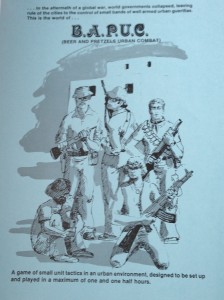
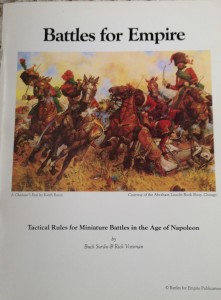
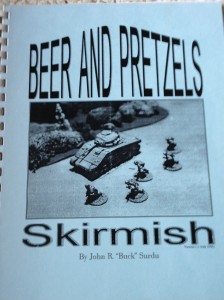
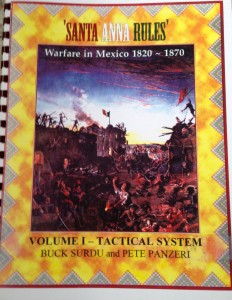
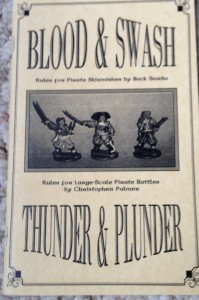
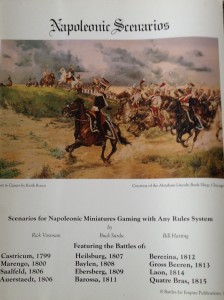
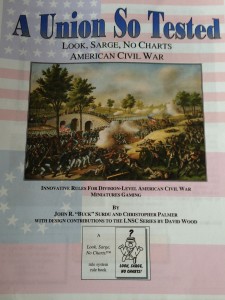
One response to “Notes on Game Design – by Buck Surdu”
Fantastic analysis by Buck.
Yes d10s work much better than d6s.
Glad someone has figured this out.
Ironically Look Sarge is not one of my favorite WWII games – but I like Buck’s approach none the less.
Tom Thomas